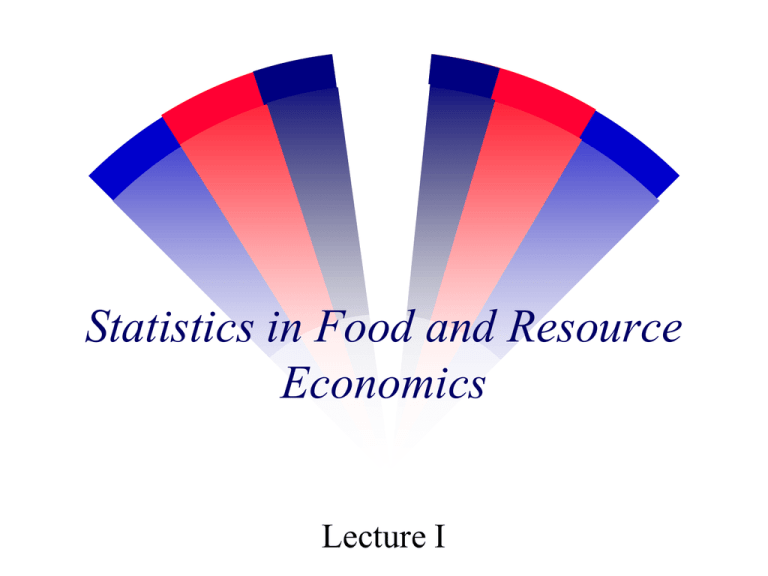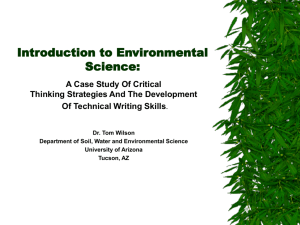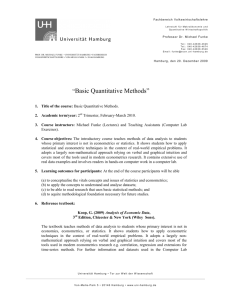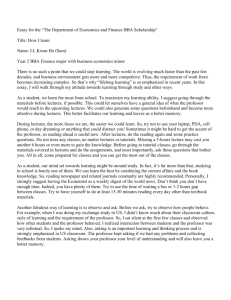
Statistics in Food and Resource
Economics
Lecture I
Course Overview
This course develops statistical foundations
that will be used in microeconomic theory,
econometrics, production economics, and
financial economics. The development
focuses primarily on the mathematical
formulation of statistics
Instructor:
Phone:
Email:
Charles B. Moss
1130B McCarty Hall
392-1845 Ext. 404
cbmoss@ifas.ufl.edu
Three lectures a week: M-W-F.
Grades in the course will be assigned based
on:
• Three examinations
• Weekly homework
• Class participation
Books
• Amemiya, Takeshi Introduction to Statistics and
Econometrics (Cambridge, Massachusetts: Harvard
University Press, 1994)
• Casella, George and Roger L. Berger. Statistical
Inference Second Edition (Pacific Grove, CA:
Duxbury, 2002).
• Hogg, Robert V., Joseph W. McKean, and Allen T.
Craig. Introduction to Mathematical Statistics Sixth
Edition (Upper Saddle River, NJ: Pearson Prentice
Hall, 2005).
• Other materials such as lecture notes will be
made available on the Internet at
http://ricardo.ifas.ufl.edu/aeb5515.mathstat/syllabus.html
Grades
Homework
Two Mid Term Examinations
Final Examination
Class Participation
15%
50%
30%
5%
Outline
Section I
• Introduction to Statistics, Probability and
Econometrics (2 Lectures)
• Random Variables and Probability
Distributions (3 Lectures)
• Moments and Moment Generating Functions (3
Lectures)
• Binomial and Normal Random Variables (3
Lectures)
Test I
Section II
• Large Sample and Asymptotic Theory (3
Lectures)
• Point Estimation (3 Lectures)
• Interval Estimation (2 Lectures)
• Testing Hypotheses (4 Lectures)
Test II
Section III
• Elements of Matrix Analysis (2 Lectures)
• Bivariate and Multivariate Regression (2
Lectures)
Test III (Final)-December 13 (12:30-2:30)
Introduction to Statistics,
Probability and Econometrics
What are we going to study over the next
fifteen weeks and how does it fit into my
graduate studies in Food and Resource
Economics?
The simplest (and most accurate) answer to
the first question is that we are going to
develop statistical reasoning using
mathematical reasoning and techniques.
Use of Mathematical Statistics in
Food and Resource Economics
From a general statistical perspective,
mathematical statistics allow for the
formalization of statistical inference.
• How do we formulate a test for quality (light
bulb life)?
• How do we develop a test for the significance
of an income effect in a demand equation?
Related to the general problem of statistical
inference is the study of Econometrics.
• “Econometrics is concerned with the systematic
study of economic phenomena using observed
data.” Spanos p. 3.
• “Econometrics is concerned with the empirical
determination of economic laws.” Theil p.1.
• Econometrics is the systematic study of
economic phenomena using observed data and
economic theory.
Economic theory, most particularly
production economics, relies on the implicit
randomness of economic variables to
develop models of decision making under
risk:
• Expected Utility Theory
• Capital Asset Pricing Models
• Asymmetric Information
Example of the Dichotomy
An Example of Inference versus Decision
Making
• Skipping ahead a little bit, the normal
distribution function depicts the probability
density for a given outcome x as a function of
the mean and variance of the distribution:
f x; , 2
2
1
x
exp
2
2
2
0.4
0.3
0.2
0.1
-3
-2
-1
1
2
3
• Statistical inference involves testing a sample
of observations drawn from this data set against
an alternative assumption, for example = 2.
• Economic applications involve the choice
between the two distribution functions.
What is Probability
Two definitions:
• Bayesian – probability expresses the degree of
belief a person has about an event or statement
by a number between zero and one.
• Classical – the relative number of time that an
event will occur as the number of experiments
becomes very large.
rO
lim PO
N
N
What is statistics?
Definition I: Statistics is the science of
assigning a probability of an event on the
basis of experiments.
Definition II: Statistics is the science of
observing data and making inferences about
the characteristics of a random mechanism
that has generated the data.
Random Variables
By random mechanisms, we are most often
concerned with random variables:
• A Discrete Random Variable is some outcome
that can only take on a fixed number of values.
• The number of dots on a die is a classic example of
a discrete random variable.
• A more abstract random variable is the number of
red rice grains in a given measure of rice.
A Continuous Random Variable represents
an outcome that cannot be technically
counted.
• Amemiya uses the height of an individual as an
example of a continuous random variable. This
assumes an infinite precision of measurement.
• The normally distributed random variable
presented above is an example of a continuous
random variable.
The exact difference between the two types
of random variables has an effect on notions
of probability.
• The standard notions of Bayesian or Classical
probability fit the discrete case well. We would
anticipate a probability of 1/6 for any face of
the die.
• In the continuous scenario, the probability of
any outcome is zero. However, the probability
density function yields a measure of relative
probability.
• The concepts of discrete and continuous
random variables are then unified under the
broader concept of a probability density
function.
Definition III: Statistics is the science of
estimating the probability distribution of a
random variable on the basis of repeated
observations drawn from the same random
variable.
Exercises
Amemiya
• Page 17 - 1, 3, 4, 7







